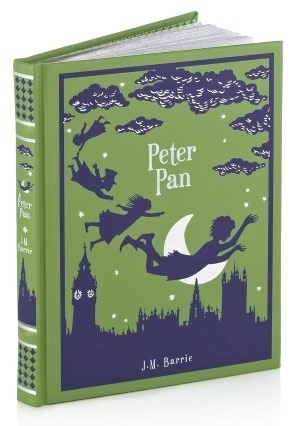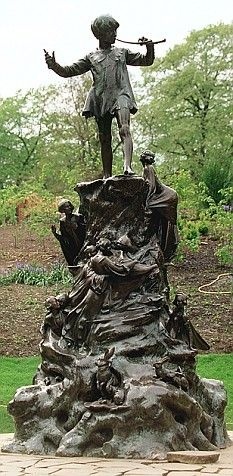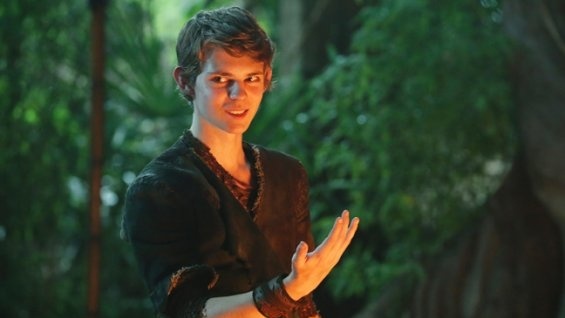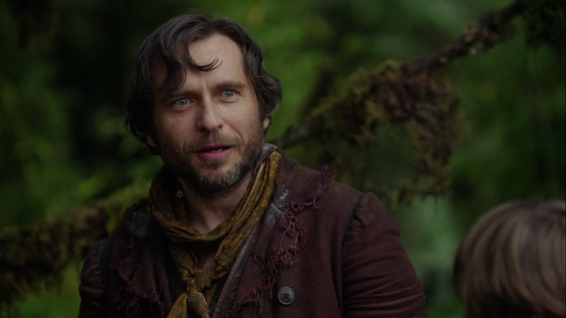|
By Lori J. Fitzgerald J.M. Barrie's Peter Pan, first performed on stage in 1904 and later novelized in 1911, is a classic of children's literature. It's famous setting, Neverland, is a treasure map filled with adventures and fanciful characters of a child's imagination: secret hideaways, fights with pirates, daring rescues of Indian princesses, mermaids in lagoons, flights through the air, a boy who never grows up. However, upon reading Peter Pan as an adult, Neverland and its denizens take on a darker atmosphere in the older and wiser mind. Adam Horowitz and Eddy Kitsis often said they based their portrayal of Peter Pan as a twisted character on the question, "What type of person would refuse to grow up?" Once Upon a Time's version of Peter Pan and Neverland take on the exact sinister atmosphere that an adult reader senses lurking underneath the whimsical plot of Barrie's book. In Once Upon a Time, Neverland is a place "where imagination runs wild," and similarly, in Barrie's book, the Neverland is part of the map of a child's mind: I don't know whether you have ever seen a map of a person's mind. Doctors sometimes draw maps of other parts of you, and your own map can become intensely interesting, but catch them trying to draw a map of a child's mind, which is not only confused, but keeps going round all the time. There are zigzag lines on it, just like your temperature on a card, and there are probably roads on the island, for the Neverland is always more or less an island, with astonishing splashes of colour here and there, and coral reefs and rakish-looking craft in the offing, and savages and lonely lairs, and gnomes who are mostly tailors, and caves through which a river runs, and princes with six elder brothers, and a hut fast going to decay, and one very small old lady with a hooked nose. It would be an easy map if that were all, but there is also first day of school, religion, fathers, the round pond, needle-work, murders, hangings, verbs that take the dative, chocolate pudding day, getting into braces, say ninety-nine, three-pence for pulling out your tooth yourself, and so on, and either these are part of the island or they are another map showing through, and it is all rather confusing, especially as nothing will stand still (p.4). The landscape and characters of Neverland also vary for each child. When children play in Neverland by day, they know they are playing make-believe, but at night it becomes real in dreams (and hence the need for night-lights). When Wendy and her brothers fly to Neverland, their imaginative place also becomes truly real. Thus, the Neverland is a place where the lines between imagination and reality blur and meld, and make-believe tea is as real and satisfying as an actual meal. "The cooking, I can tell you, kept her [Wendy's] nose to the pot, and even if there was nothing in it, even if there was no pot, she had to keep watching that it came aboil just the same" (p. 63). Even Malcolm, Rumplestiltskin's father, proclaims, "I don't even know if this place is real!" before he and little Rumple jump through the portal. But Neverland is also a place of danger as well as fun: "He [Peter] often went out alone, and when he came back you were never absolutely certain whether he had had an adventure or not. He might have forgotten it so completely that he said nothing about it; and then when you went out you found the body; and, on the other hand, he might say a great deal about it, and yet you could not find the body" (p.65). We see the same dangerous merging of reality and fantasy in Once Upon a Time's first half of Season Three, with such "mind game" events as Peter Pan's switch of Pandora's Box, Belle's appearance to Rumple, and the tests in Echo Cave. The sinister quality that pervades both Neverlands also runs through the veins of both versions of Peter Pan, who are actually more alike than not. Both Pans are cocky; in Barrie it is Peter's cockiness that lies at the root of Hook's hatred of him. Both Pans are manipulative and prey on other's insecurities to get what they want. In Barrie, Peter completely plays to Wendy's desire to pretend she is a mother and be in charge in order to get her to come to Neverland. In Once, Peter Pan also uses his words to twist Henry, Emma, and even Rumple. This cockiness and manipulation are also seen in the flashback to Malcolm as he plays Follow the Lady both with the cards and figuratively with his son. But in Barrie's book, it is Peter Pan's callous forgetfulness, selfishness, and total lack of empathy that make him a sinister figure, causing any adult reader to be utterly disturbed at the implications of a perpetual child. "Children have the strangest adventures without being troubled by them. For instance, they may remember to mention, a week after the event happened, that when they were in the wood they had met their dead father and had a game with him." Above: Peter Pan's Statue in Kensington Gardens, London But in Barrie's book, it is Peter Pan's callous forgetfulness, selfishness, and total lack of empathy that make him a sinister figure, causing any adult reader to be utterly disturbed at the implications of a perpetual child. "Children have the strangest adventures without being troubled by them. For instance, they may remember to mention, a week after the event happened, that when they were in the wood they had met their dead father and had a game with him" (p.6). We first see Peter's utter callousness in his desire for everything to be a constant game when he is flying the children to Neverland, much like Pan's "Let's play," in Once: Certainly they did not pretend to be sleepy, they were sleepy; and that was a danger, for the moment they popped off, down they fell. The awful thing was Peter thought this was funny. "There he goes again," he would cry gleefully, as Michael suddenly dropped like a stone. "Save him, save him!" cried Wendy, looking with horror at the cruel sea far below. Eventually Peter would dive through the air, and catch Michael just before he could strike the sea, and it was lovely they way he did it; but he always waited till the last moment, and you felt it was his cleverness that interested him and not the saving of human life. Also he was fond of variety, and the sport that engrossed him one moment would suddenly cease to engage him, so there was always the possibility that the next time you fell he would let you go (p.33). Peter is referred to many times as happy, innocent, and heartless. The perpetual child is the constant id: always seeking selfish pleasure, never learning empathy or morals or social etiquette from a parent. Peter's mind as a child is always in flux and focused on himself, so he often forgets people and events. He almost forgets who the children are when they are flying to Neverland, often cannot remember whether he had an adventure or not, and even eventually forgets his great battle with his nemesis, Hook. Because he forgets, and does not have parental influences to reinforce such lessons, he never learns from experiences or mistakes and never develops empathy for others. Although the ramifications of this can be horrifying, and in fact, Peter often comes across as petulant and mean in Barrie's book (as well as in Once), we as readers take it with a small grain of salt because he is ultimately a child. Barrie often reminds us that Peter still has all his baby teeth, and this fact melts the heart of Mrs. Darling when she encounters him. However, when the same type of callous, child-like games are played by adults, the contrast is ridiculous and dastardly. Mr. Darling displays "bad form," as Hook would say, and horrifies even his children when he puts his medicine in the dog's bowl for her to drink. Later on in the book he places himself in the dog's kennel in penance for chaining the dog up and preventing her from protecting the children, but starts to look even more ridiculous when he brings the kennel to and from work because he is enjoying the attention that he is getting! In Once Upon a Time, we see Malcolm's irresponsible and selfish life in the flashback. He does not have a job, but tries to win money through cheating and card tricks. He dumps his son with the spinsters, telling him he is looking for work, but instead is at the pub. Malcolm wants to be in Neverland because if you think something, it will happen; in other words, no hard work is involved in getting exactly what you want when you want it. Neverland provides immediate, constant gratification, which is what children want unless they learn the value of patience and effort. Neverland also appeals to Malcolm because it is a place where you will have not a care in the world; he considers this freedom. He shows contempt instead of fatherly understanding for his little son who is afraid of heights and even more afraid of being without him, the son who wisely tells him "You are not a boy anymore," which he does not want to hear. "I want to fly," he proclaims, his face blazing with selfish desire. In this selfishness, Malcolm traumatizes his son by giving him up to become Peter Pan, the perpetual child, and we find him reprehensible for it. This is the type of person who would want to never grow up: one who is "heartless".
J. M. Barrie's book is considered children's literature not only because it has children as protagonists but also because on the surface it filled with exciting adventures and fantastical figures. However, to the adults readers who visit Neverland, and the adult characters in Once Upon a Time who must save Henry, Neverland is a dangerous place and Peter Pan is a fearsome character. Like many of the original fairy tales that Once has re-constructed, this children's book has a definite, perhaps darker message for adults. It shows the dangers of a child who is never taught empathy or selflessness. Paradoxically, that child can "grow up" into an adult like Rumplestiltskin's father, selfish and irresponsible, and ultimately willing to abandon his own child for his pleasure. Adam and Eddy referred to Neverland as the "heart of darkness," and it is a heart darkened with lack of empathy and selfishness that wants to never grow up. It is a dangerous game to play indeed.
0 Comments
Leave a Reply. |
OriginsExplore the Arthurian legend surrounding Lancelot, take a trip into the woods to discover the mythology behind Red Riding Hood or learn more about a modern day hero called Snow White. Origins provides unique insights and perspectives from talented writers into the characters we know and love, going far beyond the boundaries of Storybrooke. Archives
August 2016
Categories
All
|




